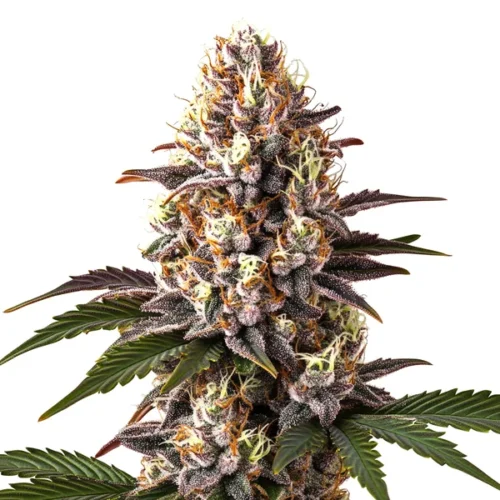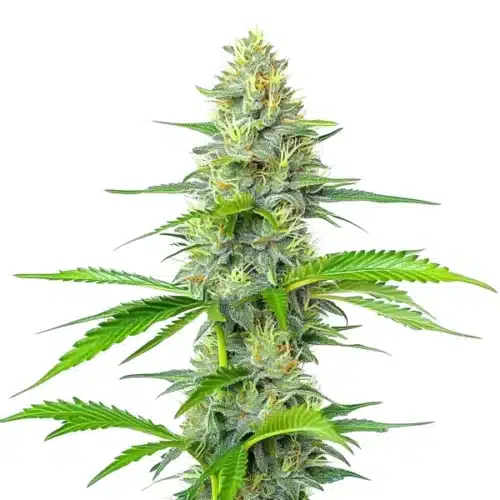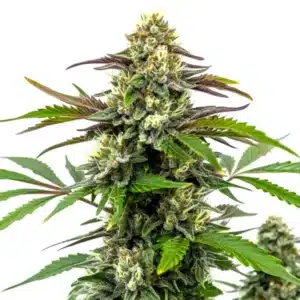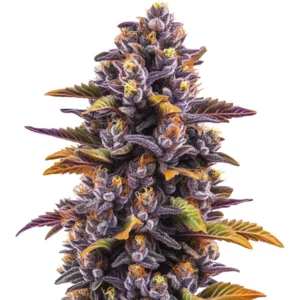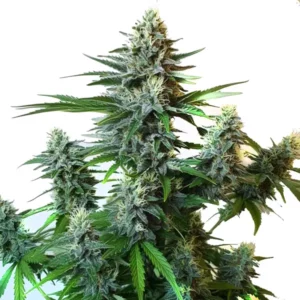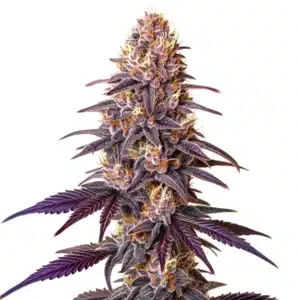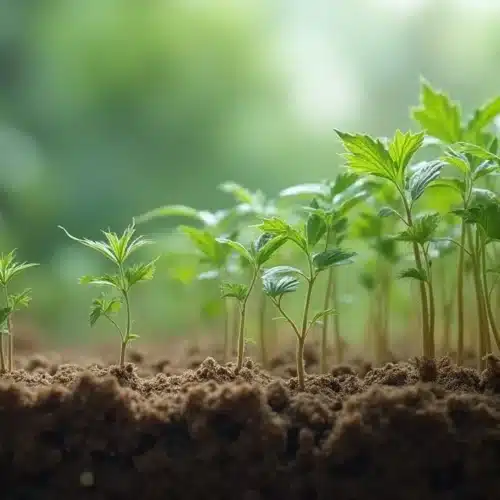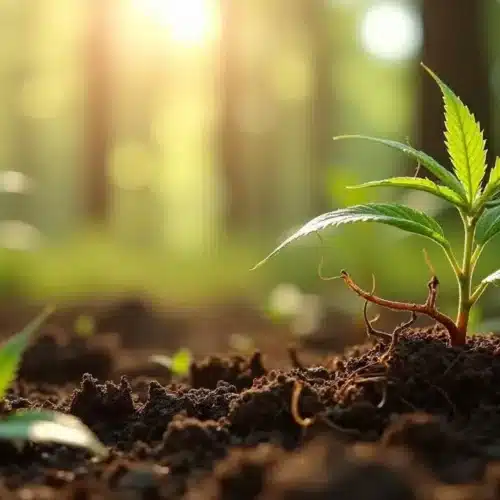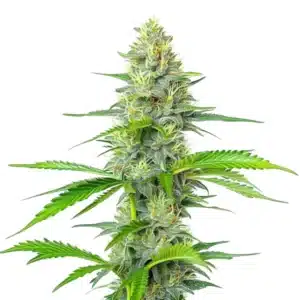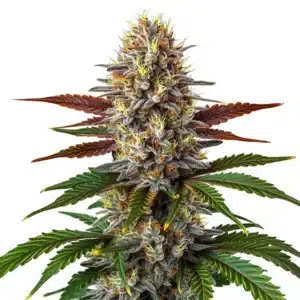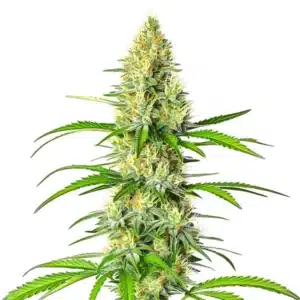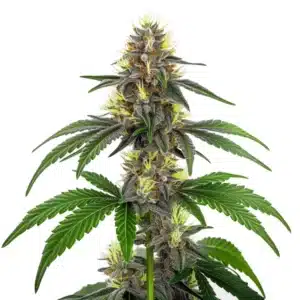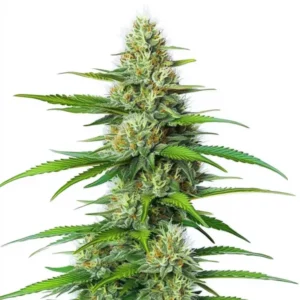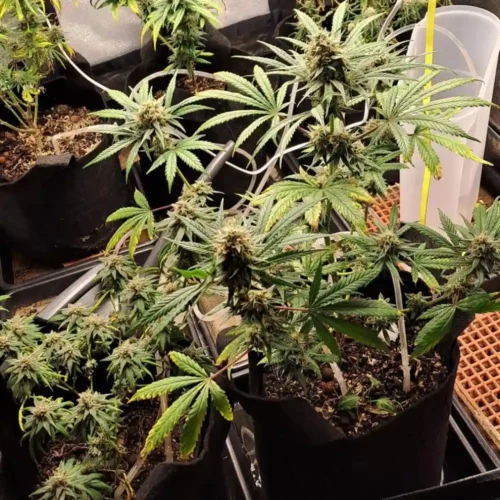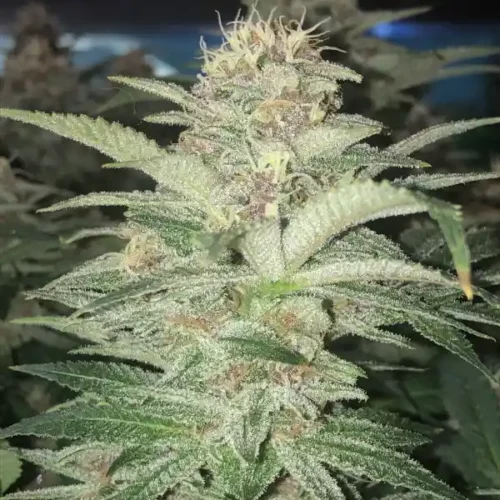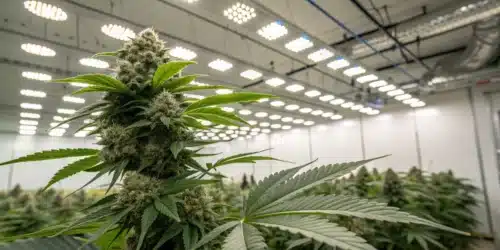Blue Widow Weed Strain Cannabis Seed Description
Here’s essential Blue Widow strain info: this highly sought-after hybrid cannabis strain is admired for its robust effects and captivating aroma. This strain emerges from the genetic fusion of two legendary varieties: Blueberry and White Widow, resulting in a plant that showcases the best attributes of both parents.
Visually, Blue Widow is a spectacle to behold, boasting dense, resinous buds that glisten with trichomes, often displaying a mesmerizing bluish hue that distinguishes it from other strains. Its aroma is a delightful marriage of fruity sweetness inherited from Blueberry and the earthy, spicy undertones characteristic of White Widow.
Recommended Strains
Blue Widow
 THC: 12% - 17%
THC: 12% - 17% Type of seed: Feminized
Type of seed: Feminized Phenotype: Mostly Indica
Phenotype: Mostly Indica Day to flower: 8 - 10 weeks
Day to flower: 8 - 10 weeks
Blueberry x White Widow
 THC: 22% - 27%
THC: 22% - 27% Type of seed: Feminized
Type of seed: Feminized Phenotype: Mostly Indica
Phenotype: Mostly Indica Day to flower: 8 - 10 weeks
Day to flower: 8 - 10 weeks
What sets Blue Widow apart is its potent THC content, typically ranging from 18% to 22%, delivering a powerful psychoactive experience cherished by cannabis connoisseurs.
Promos & Deals
Environmental Requirements for Growing Blue Widow Strain
Blue Widow cannabis thrives when grown under the right environmental conditions, making meticulous attention to climate and soil factors paramount:
Blue Widow thrives in conditions akin to the Mediterranean climate, favoring temperatures between 70-80°F (21-27°C) during the day and slightly cooler nights. Maintaining stable humidity levels around 40-50% is crucial to thwart mold and mildew.
Indoor growers should invest in robust ventilation systems and high-quality LED grow lights to simulate optimal sunlight conditions. Outdoor cultivation necessitates selecting a sun-drenched locale with well-draining soil to ensure vigorous plant development.
Setting Up The Growing Cannabis Space
Whether cultivating indoors or outdoors, creating an optimal growing environment is foundational to success:
Indoor growers should procure a suitable grow tent equipped with efficient ventilation and reflective interior walls to maximize light distribution. Selecting premium soil or a hydroponic setup is recommended, alongside ample spacing between plants to facilitate healthy growth.
For outdoor cultivation, prepping the soil with organic nutrients and considering the use of fabric pots to enhance root health are prudent measures. Shielding plants from gusty winds and potential pest intrusions with natural deterrents or barriers is essential for safeguarding their well-being.
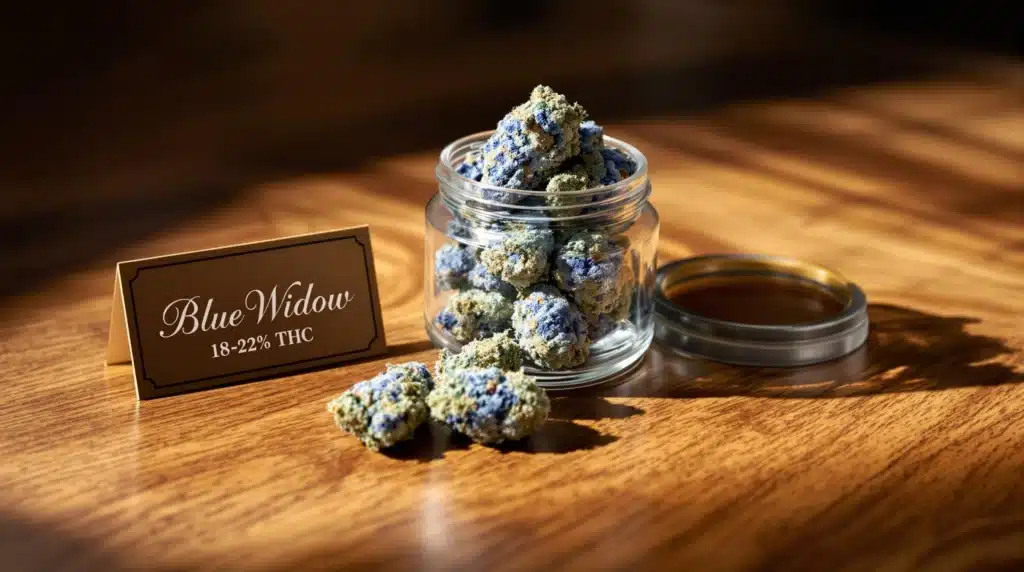
Propagation and Germination of Marijuana Blue Widow Seeds
Establishing robust seedlings sets the stage for a successful Blue Widow weed strain cultivation journey. Here’s an in-depth exploration of the propagation and germination process for Blue Widow seeds:
Seed Selection: Begin your Blue Widow weed strain cultivation adventure by acquiring high-quality feminized seeds from reputable suppliers or seed banks. Opting for feminized seeds ensures genetic stability and eliminates the hassle of identifying and culling male plants during the growth cycle.
Pre-Germination Preparation: Before initiating the germination process, prepare your seeds by placing them in a container filled with distilled water or a damp paper towel. Allow the seeds to soak for 24 to 48 hours in a warm, dark environment. This pre-soaking step jumpstarts the germination process by softening the seed coat and encouraging the emergence of the taproot.
Germination Method: After the pre-soaking period, carefully transfer the prepped seeds to a germination medium. This medium can be a small pot filled with moist, well-draining soil, a seedling tray, or rock wool cubes. Ensure the germination medium is light and airy to facilitate root development and prevent damping-off.
Ideal Germination Conditions: Maintain optimal environmental conditions to support seed germination. Blue Widow seeds thrive in a warm, humid environment with temperatures ranging between 70-85°F (21-29°C). Provide gentle airflow to prevent stagnant air around the seeds, which can lead to fungal growth.
Germination Timeframe: Blue Widow seeds typically germinate within 2 to 7 days under favorable conditions. Monitor the germination progress closely, keeping the germination medium consistently moist but not waterlogged. Avoid disturbing the seeds unnecessarily during this critical phase to prevent damage to emerging root structures.
Transplanting Seedlings: Once the Blue Widow weed strain seedlings have developed a robust taproot and emerged from the germination medium, it’s time to transplant them into their permanent growing containers or designated grow space. Handle the delicate seedlings with care, ensuring minimal disturbance to the roots.
Lighting and Nutrient Considerations: After transplanting, provide gentle lighting to prevent seedlings from becoming stressed. Avoid exposing them to intense light sources initially, gradually acclimating them to brighter light conditions over time. Begin feeding seedlings with a diluted nutrient solution formulated for young cannabis plants, gradually increasing nutrient strength as they mature.
By adhering to these germination guidelines and nurturing your Blue Widow seedlings with care and attention, you can set the stage for a thriving cannabis cultivation journey. Remember to monitor seedling health closely and adjust environmental variables as needed to optimize growth and development.
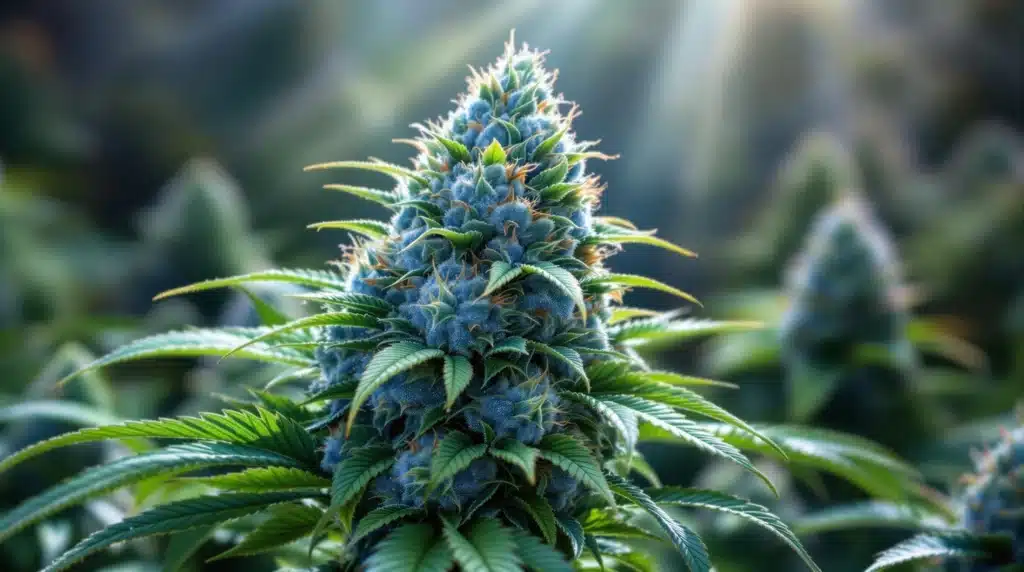
Vegetative Phase of Cannabis seeds blue widow weed strain
During the vegetative phase of cultivating Blue Widow weed strain, growers witness the remarkable development of the plant’s structure and foliage. This crucial stage sets the foundation for robust growth and ensures the plants are adequately prepared for the flowering phase. Here’s a deeper dive into the vegetative phase of Blue Widow:
Optimal Lighting: Blue Widow weed strain plants demand ample light during the vegetative stage to fuel photosynthesis and encourage vigorous growth. Providing 18-20 hours of light per day mimics long daylight hours, promoting vegetative development. High-quality LED grow lights or HPS lamps emit the spectrum of light necessary for lush foliage expansion.
Nutrient Requirements: During vegetative growth, Blue Widow plants require a nutrient-rich diet, with an emphasis on nitrogen (N) to support leafy growth and stem development. A balanced fertilizer with higher nitrogen content aids in maintaining healthy, vibrant foliage. However, it’s crucial to monitor nutrient levels closely to prevent nutrient imbalances, which can manifest as deficiencies or toxicities.
Watering Practices: Consistent watering is essential to sustain Blue Widow’s vegetative vigor. Ensure the soil remains evenly moist, avoiding overwatering that could lead to root rot or under-watering, which may stunt growth. Monitoring the top inch of the soil’s moisture level and adjusting watering frequency accordingly helps maintain optimal hydration levels for the plants.
Training Techniques: Implementing training methods during the vegetative phase can shape Blue Widow weed strain plants for improved yield and manage their overall structure. Techniques such as low-stress training (LST), topping, or defoliation promote lateral growth, enhance light penetration, and create an even canopy. These practices contribute to maximizing bud sites and ultimately lead to higher yields during flowering.
Environmental Considerations: Creating an optimal environment is pivotal for robust vegetative growth. Ensure proper ventilation to prevent heat buildup and humidity control to discourage mold and mildew formation. Adequate airflow around the plants strengthens stems and minimizes the risk of pests or diseases. Maintaining stable temperatures between 70-80°F (21-27°C) fosters optimal metabolic processes within the plants.
Monitoring and Care: Regular observation and attentive care are paramount during the vegetative phase. Keep a keen eye on plant health, checking for signs of nutrient deficiencies, pest infestations, or environmental stressors. Adjust nutrient levels, environmental conditions, and training techniques as needed to address any issues promptly and maintain optimal growth.
Transition to Flowering: As Blue Widow plants approach maturity in the vegetative phase, growers can initiate the transition to the flowering stage by adjusting the light cycle to 12 hours of light and 12 hours of uninterrupted darkness. This shift signals to the plants that it’s time to shift focus from vegetative growth to bud production, marking a significant milestone in the cultivation journey of Blue Widow weed strain.
By providing attentive care, optimizing environmental conditions, and implementing appropriate training techniques, growers can ensure that their Blue Widow plants thrive during the vegetative phase, setting the stage for a bountiful harvest of high-quality buds in the flowering stage.

Flowering Phase of Marijuana Seeds Blue Widow Weed Strain
During the flowering phase of Blue Widow weed strain, the plant undergoes a remarkable transformation as it shifts its focus from vegetative growth to the development of dense, resinous buds. This phase is eagerly anticipated by growers, as it marks the culmination of their efforts and the onset of the plant’s reproductive cycle.
Lighting: Adjusting the light cycle to 12 hours of light and 12 hours of uninterrupted darkness signals to the Blue Widow plants that it’s time to flower. Adequate lighting is essential during this stage to ensure optimal bud development. High-intensity grow lights or natural sunlight should be maintained at the appropriate distance from the canopy to prevent light burn while providing sufficient illumination for robust bud formation.
Nutrition: As Blue Widow transitions into the flowering phase, its nutritional requirements shift to support prolific bud growth. Switching to a bloom-specific nutrient formula rich in phosphorus and potassium promotes flowering and enhances bud density. It’s crucial to monitor nutrient levels closely, adjusting concentrations as needed to prevent deficiencies or excesses that could compromise bud quality.
Temperature and Humidity: Maintaining optimal temperature and humidity levels is crucial during flowering to maximize resin production and minimize the risk of mold or bud rot. Temperatures between 65-75°F (18-24°C) are ideal, while humidity should be kept around 40-50%. Proper ventilation and airflow within the grow space help to regulate temperature and humidity levels, ensuring a conducive environment for healthy bud development.
Support: As the Blue Widow plants enter the flowering phase, the weight of developing buds may cause branches to bend or break. Providing structural support in the form of stakes or trellises helps to bolster branches and prevent damage, ensuring that the plants can support the weight of their burgeoning buds without succumbing to stress or injury.
Flowering Time: Blue Widow typically has a flowering time of 8-9 weeks, though this may vary depending on environmental factors and the specific phenotype of the plant. Monitoring trichome development using a magnifying tool allows growers to gauge the optimal harvest window, ensuring peak potency and flavor. Harvesting too early may result in underdeveloped buds, while waiting too long could lead to diminished potency and overripe buds.
Throughout the flowering phase, growers should remain vigilant for any signs of pests or diseases that could compromise the health and vitality of their Blue Widow plants. Implementing preventive measures and maintaining a clean and well-ventilated grow space goes a long way toward ensuring a successful flowering stage and a bountiful harvest of top-quality buds.
Cannabis Fertilization and Nutrition – Blue Widow Weed Strain
Proper nutrition management is vital for cultivating healthy and high-yielding Blue Widow plants. Here’s a more in-depth look at fertilization and nutrition strategies tailored to the specific needs of the Blue Widow weed strain:
Selecting the Right Fertilizer: Choosing a fertilizer specifically formulated for cannabis cultivation is crucial. Look for products designed for both the vegetative and flowering stages, as the nutrient requirements vary during each phase. Opt for a balanced fertilizer with adequate levels of nitrogen (N), phosphorus (P), and potassium (K), along with essential micronutrients like calcium, magnesium, and sulfur.
Feeding Schedule: Establish a feeding schedule that aligns with the growth stages of your Blue Widow plants. During the vegetative phase, when plants focus on leaf and stem development, a fertilizer higher in nitrogen is ideal. Transition to a bloom-specific nutrient formula once the plants enter the flowering stage, emphasizing phosphorus and potassium to support robust bud formation. Start with a lower concentration of nutrients and adjust as needed based on your plants’ response, taking care not to overfeed, which can lead to nutrient burn.
Supplements and Additives: Consider incorporating supplements and additives to enhance the overall nutrient uptake and health of your Blue Widow plants. Beneficial supplements may include microbial inoculants to improve soil health, organic amendments such as compost or worm castings to enrich the soil, and bloom boosters containing additional phosphorus and potassium to stimulate flower production. Additionally, foliar sprays enriched with micronutrients can address any deficiencies and promote healthy growth when applied directly to the leaves.
pH Monitoring and Adjustments: Maintaining the pH level of the growing medium is critical for ensuring optimal nutrient uptake by the Blue Widow plants. Cannabis typically thrives in slightly acidic soil with a pH range between 6.0 and 6.5. Regularly monitor the pH levels of your soil or hydroponic solution using a pH meter and adjust as necessary with pH-up or pH-down solutions to keep it within the ideal range. Fluctuations in pH can impact nutrient availability and lead to deficiencies or toxicities, affecting overall plant health and productivity.
Organic vs. Synthetic Nutrients: Growers have the option to choose between organic and synthetic nutrient formulations based on their preferences and cultivation philosophy. Organic nutrients derived from natural sources provide a holistic approach to plant nutrition, enriching the soil microbiome and promoting sustainable cultivation practices. Synthetic nutrients, on the other hand, offer precise control over nutrient concentrations and are readily available for immediate uptake by the plants. Experiment with different nutrient regimes to determine which best suits your growing style and goals.
By fine-tuning your fertilization and nutrition regimen to meet the specific requirements of the Blue Widow weed strain, you can optimize plant health, vigor, and ultimately, harvest quality and yield. Regular monitoring, adjustments based on plant response, and a commitment to providing balanced nutrition will contribute to a successful cultivation experience with Blue Widow.
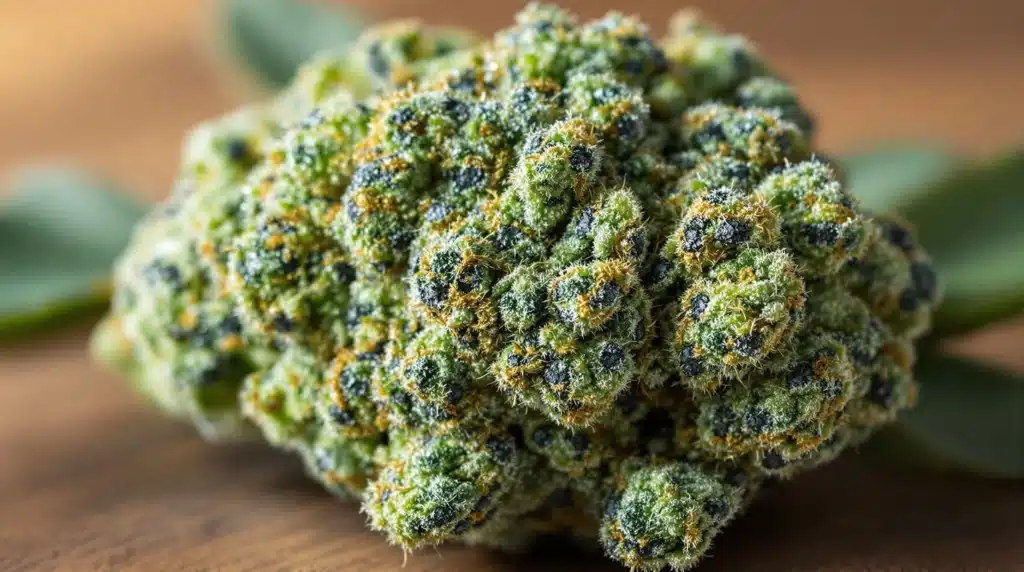
Pest And Disease Control for Cannabis Growing – Blue Widow Weed Strain
Vigilant pest management is imperative to safeguard Blue Widow’s health:
Implement proactive measures such as regular monitoring and introducing beneficial insects to mitigate pest incursions naturally. Maintaining a clean cultivation space devoid of debris and optimizing airflow curtails disease proliferation.
Utilize organic pest control solutions and employ integrated pest management (IPM) strategies to combat infestations effectively while preserving crop integrity.
Harvesting and Curing for Cannabis Growing – Blue Widow Weed Strain
Harvesting and curing Blue Widow weed strain is a crucial process that significantly impacts the quality and potency of the final product. Let’s delve deeper into each step:
Timing: Knowing the right time to harvest is crucial for Blue Widow buds. It’s best to wait until the trichomes are milky white with some amber hues, indicating peak cannabinoid and terpene levels.
Harvesting: When harvesting Blue Widow weed strain, use clean, sharp pruning shears to carefully trim the mature buds. It’s essential to handle them gently to avoid damaging the delicate trichomes. Remove any large fan leaves while leaving smaller sugar leaves intact to protect the bud structure.
Drying: After harvesting, hang the trimmed branches upside down in a dark, well-ventilated area with consistent temperatures of 60-70°F (15-21°C) and humidity levels between 45-55%. Proper airflow is essential to prevent mold and mildew while allowing the buds to dry evenly.
Curing: Once the buds are dry, transfer them to airtight glass jars, filling them to about two-thirds capacity. Store the jars in a cool, dark place with temperatures ranging from 60-70°F (15-21°C) and humidity levels around 55-65%. Remember to open the jars periodically to burp them, releasing excess moisture and allowing for proper curing. This process typically takes 2-4 weeks, during which time the buds develop richer flavors, smoother smoke, and increased potency.
Curing is a crucial step that allows Blue Widow buds to reach their full potential in terms of flavor, aroma, and effects. It requires patience and attention to detail, but the results are well worth the wait. Properly cured Blue Widow weed strain provides a superior smoking or vaping experience, delivering a balanced blend of cannabinoids and terpenes for maximum enjoyment.
Blue Widow Weed Strain Indica or Sativa?
For those wondering if Blue Widow strain is indica or sativa, it epitomizes the essence of a balanced hybrid:
Combining the sedative tranquility of Indica genetics with Sativa’s cerebral invigoration, Blue Widow delivers a harmonious fusion of effects. Whether seeking relaxation or inspiration, this versatile strain caters to diverse preferences.
Advantages of Growing Blue Widow Weed Strain Cannabis Seeds
Blue Widow weed strain offers myriad benefits that appeal to cultivators:
- Potent THC content and captivating aroma
- Balanced hybrid effects suitable for various occasions
- Resilient growth and high yield potential
- Adaptability to different cultivation environments
- Reliable genetics and ease of cultivation
Disadvantages of Growing Blue Widow Weed Strain Cannabis Seeds
Despite its virtues, Blue Widow weed strain cultivation presents certain challenges:
- Strong odor during flowering necessitates odor control measures
- Precise nutrient management required to prevent nutrient imbalances
- Potential for branch support needed due to dense bud formation
- Variable phenotypes may exhibit differing yields
Why Buy Blue Widow Weed Strain Marijuana Seeds
Investing in Blue Widow seeds offers numerous compelling reasons:
1. Exquisite Aroma and Potency: Blue Widow’s aromatic profile and potent effects ensure a gratifying sensory experience.
2. Versatile Effects: From relaxation to creative inspiration, Blue Widow caters to diverse recreational and medicinal needs.
3. Proven Genetics: With Blue Widow’s lineage boasting renowned parent strains, its genetic stability and reliability are assured.
4. Cultivation Accessibility: Novice and experienced growers alike can achieve success with Blue Widow, thanks to its resilient nature and straightforward cultivation requirements.
5. Widely Available: Blue Widow seeds are readily accessible from reputable seed banks and dispensaries, ensuring authenticity and quality.

